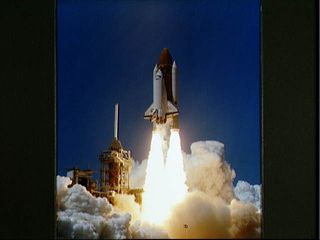A Man of Peerless Honour
"So I raised my hand. I said, 'Morton Thiokol was so concerned, we recommended not launching below 53 degrees Fahrenheit [11C-].""And we put that in writing and sent that to NASA'.""I'll never forget Chairman [William] Rogers said, 'Would you please come down here on the floor and repeat what I think I heard'?"Allan McDonald, rocket scientist
 |
Allan McDonald, employed as senior on-site representative of contractor Morton Thiokol to oversee the engineering of the rocket boosters for the Challenger space shuttle launch, refused to sign off over safety concerns. He should have been heeded, as a professional rocket scientist, a man with a reputation as one of the most skilled of rocket engineers nationwide.
That day, January 28, 1985 was unseasonably cold for Florida, the weather uncooperative, temperature down to -8C before scheduled liftoff. A condition of weather inimical to the proceedings at hand, one which occasioned stressful debate between NASA officials and company executives at Morton Thiokol at Cape Canaveral, Florida that day at the Kennedy Space Center.
![[object Object]](https://www.tampabay.com/resizer//kCjw4sMBOMGxlyDRrOa9VIZAc0E=/1600x0/smart/arc-anglerfish-arc2-prod-tbt.s3.amazonaws.com/public/FOBV4AB2ZJD4NG7RG7JZ5G3M6E.JPG) |
| The space shuttle Challenger explodes shortly after lifting off from Kennedy Space Center in this Jan. 28, 1986 file photo. All seven crew members died in the explosion, which was blamed on faulty O-rings in the shuttle's booster rockets. The disaster shattered NASA's image and the belief that flying on a spacecraft could become as routine as flying on an airplane. |
Takeoff as scheduled reasoned Engineer McDonald should be set aside under those cold conditions, postponed. Simply put, a critical component of the rocket booster, a rubber gasket called an O-ring serving to contain burning fuel would be deleteriously impacted by the cold. Engineers had given warning that the effectiveness of the enterprise was at stake since the rubber gasket could not be guaranteed to hold in temperatures under 11C.
The night before launch stuck in Mr. McDonald's memory for its stressed discussion prior to launch at a time that NASA was anxious to move forward, and company executives were under pressure to "accommodate a major customer". Although Mr.McDonald simply balked, refusing to sign off on the launch, his supervisor had no such scruples and signed off enabling the Challenger to lift off at 11:38 a.m. on January 28.
 |
| NASA lost seven of its own on the morning of Jan. 28, 1986, when a
booster engine failed, causing the Shuttle Challenger to break apart
just 73 seconds after launch. NASA |
About 72 seconds later the Challenger disintegrated. "My heart just about stopped", Mr.McDonald later recollected. A commission of enquiry was convened by President Ronald Reagan to investigate the calamity. Those whose lives were lost were Teacher in Space
Participant, Sharon "Christa" McAuliffe, Payload Specialist, Gregory
Jarvis, Mission Specialist, Judy Resnik, Commander Dick Scobee. Mission
Specialist, Ronald McNair, Pilot, Michael Smith and Mission Specialist,
Ellison Onizuka.
Engineer McDonald appeared at the hearings, seated he said, in the cheap seats. He was there when a NASA official testified with "misleading" information about the debate that led to the takeoff. As a result of his confronting the hearing with the truth after the NASA official's statement, Mr.McDonald was demoted at Morton Thiokol. Congress threatened to end the company's federal contracts if he was not re-hired, and he was reinstated.
He went on to continue working for Morton Thiokol after reinstatement, redesigning booster rockets. When he retired in 2001, it was as the company's vice-president. Allan McDonald left his place on Earth on March 6, in Ogden, Utah. He was 83 years old. He died of complications from a fall.
![[object Object]](https://www.tampabay.com/resizer//_5UD4_VmHc6goy1jxJdifD-0RzI=/1600x0/smart/arc-anglerfish-arc2-prod-tbt.s3.amazonaws.com/public/3QLWM2N3Q5CPVGO3OIB2HKT3XY.jpg) |
Labels: 1937-2021, Allan McDonald

<< Home